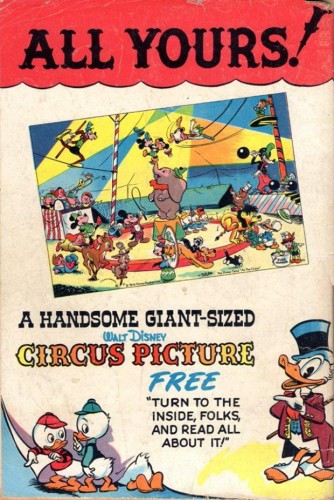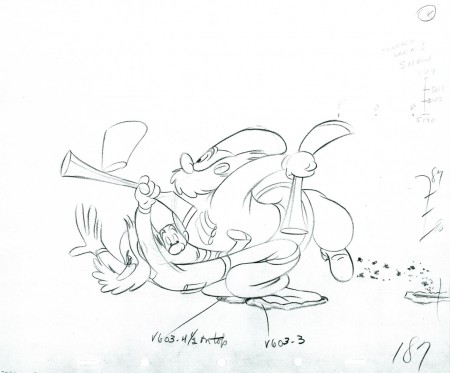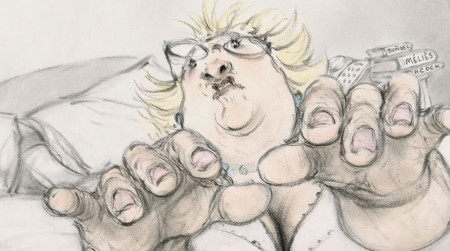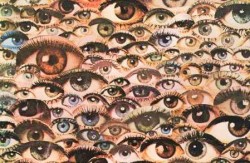Category ArchiveCommentary
Bill Peckmann &Comic Art &Commentary &Disney &Illustration 10 Jul 2010 07:32 am
More on Give-aways
On the post about Give-aways, I had a little story I was going to add, and at the last moment, I decided not to include it,=. So, why not now?
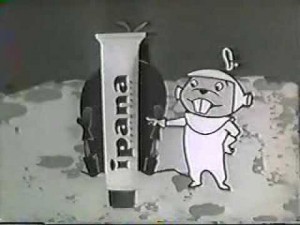 Back in 1957, when the original Mickey Mouse Club was in full swing, in conjunction with Ipana toothpaste, there was a TV offer of a mail-in of a book which included puppets of Jiminy Cricket and Pinocchio. As a puppet fan, I raced through the tube of Ipana to get to the new packaging to send away for it. $.50 for postage and handling.
Back in 1957, when the original Mickey Mouse Club was in full swing, in conjunction with Ipana toothpaste, there was a TV offer of a mail-in of a book which included puppets of Jiminy Cricket and Pinocchio. As a puppet fan, I raced through the tube of Ipana to get to the new packaging to send away for it. $.50 for postage and handling.
It took about a month to receive the book of cardboard pages. There, inside, were punch-out pieces of Jiminy and Pinocchio. By following the instructions, you could put together puppets of the two characters. It was rather complex, but I did it, and boy was I pleased with the end result. By manipulating tabs in the back you could operate the mouth (similar to a ventriloquists puppet) of Jiminy – he always was the talker.
Pinocchio was the marionette and was operated by string. I still remember this give-away gift as if it were yesterday, and I’ve searched the internet for pictures of the book, but haven’t found it. I’m sure I eventually will.
Mind you, I’d made my own marionettes and hand-puppets by the time I came upon this book. I was 10-12 at the time and, through a book I’d borrowed from the library, I found that I could cut and sew muslin, stuffed with more muslin, to make some fine puppets. They all looked a bit like Mr. Potato Head when they were finished, but I was proud of them just the same.
Likewise, there was a book once put out by Dover publishing. Called Motion Picture Toys. The cardboard pages included punch-out objects that, when assembled, produced early animation machines: Praxinoscope, anascope and especially an excellent Zoetrope with animated strips. I remember using this book as a guide and followed it closely to make my own zoetropes that I gave to my siblings one Christmas. Of course, I did my own animated strips that they could interchange.
I’ve searched for that booklet, too, but have had no luck. I’ve even written to the company hoping they’d have some back copies they’d sell me, but they’re not to be found. Of course, that book wasn’t free, but it was pretty cheap and reminded me of the Jiminy/Pinocchio giveaway.
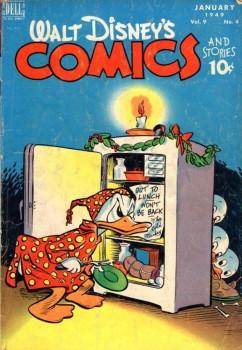 - Michael Barrier left a comment on my Giveaways post, yesterday, and referenced a comic giveaway which was drawn by Walt Kelly featuring a circus milieu. Here’s that part of his comment reprinted:
- Michael Barrier left a comment on my Giveaways post, yesterday, and referenced a comic giveaway which was drawn by Walt Kelly featuring a circus milieu. Here’s that part of his comment reprinted:
- Kelly definitely did draw what I think is the most wonderful WDC&S subscription premium, a 10 x 14 (I think, without taking my framed copy down from the wall to measure it) sheet called “The Disney Gang at the Circus,†which shows about 30 Disney characters under the big top, doing all sorts of funny Kelly stuff.
Mike couldn’t illustrate that cover, but here is the ad for that giveaway, courtesy of Bill Peckmann.
To the right is the magazine cover of the issue that the ad appeared in.
Speaking of Mike, he has a brilliant post for all those interested in the history of Mickey Mouse. The old saw of Walt dreaming up Mickey Mouse on his train ride back from New York isn’t even considered when you read about the origins of the Mouse on Mike’s site. Stories about Ub hiding in closets aren’t even pulled out of the hat.
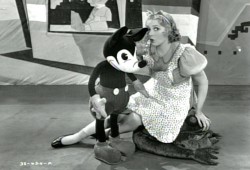 As a fan of silent animated films, I’ve seen my share of Mickey Mouse wannabes that raced after Farmer Alfalfa in all those Terry-Moser Aesop Fables. Likewise just about any other cartoon maker in the pre-Mickey world; you’d see more than your share of mice that could easily be stunt doubles for Mickey. I always assumed it was natural that Mickey just came out of these mice that all animators seemed to be drawing. But no.
As a fan of silent animated films, I’ve seen my share of Mickey Mouse wannabes that raced after Farmer Alfalfa in all those Terry-Moser Aesop Fables. Likewise just about any other cartoon maker in the pre-Mickey world; you’d see more than your share of mice that could easily be stunt doubles for Mickey. I always assumed it was natural that Mickey just came out of these mice that all animators seemed to be drawing. But no.
Mike goes into the true origins of the mouse, and the evidence seems certain.
Of course, anyone seriously interested in animation history or writing looks into Mike’s site regularly enough that I’m not reporting anything new. But for those of you who haven’t come across this essay by Mike, go there.
- John Canemaker has a new, fine piece about acting in animation on his Print Magazine blog page. Take a look.
Commentary 08 Jul 2010 07:51 am
Shorts
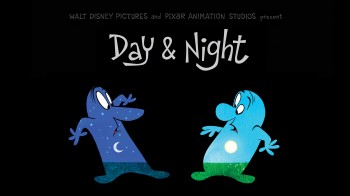 - About two weeks ago I started thinking about the state of animated short films. This was the result of my viewing the most recent Pixar short, “Day & Nightâ€. This film had a lot of the problems most Pixar shorts have, and I came to realize that it’s the same problem most shorts being made today have. The word is sophomoric.
- About two weeks ago I started thinking about the state of animated short films. This was the result of my viewing the most recent Pixar short, “Day & Nightâ€. This film had a lot of the problems most Pixar shorts have, and I came to realize that it’s the same problem most shorts being made today have. The word is sophomoric.
The stories, to my taste, are just too lacking in real intelligence. Early shorts from Pixar seemed to be trying to advance their hardware; for example, “For the Birds” was pushing the envelope on cgi rendering of feathers. (As it turns out, this is one of their better short films; the story is well written and timed.) Later shorts from them are trying to push some other limit, but they just are not.
I’m not concerned with the technique used in these films or the quality of the animation. After all Pixar is paying millions of dollars for these tiny films; they should be well animated, designed and produced. And, for the most part, they are. Pixar tags them onto a blockbuster effort like Toy Story 3 and is able to recoup the investment – something the average Independent will probably never do.
In this film, “Day & Night”, the two principal characters, drawn in 2D animation, are surrounded with a black matte. The interior coloring of the characters is filled with computer animation images of day, for the first character, and night, for the second. One is jealous of the other – until, of course, midnight passes and Day becomes Night, and vice versa. Over the last minute or so, we’re given some pompous narration to make it sound like it’s an important theme and film. The whole enterprise feels lifted from other, more original films done many years ago. The only difference, really, is that this is in gorgeous 3D – a nice package.
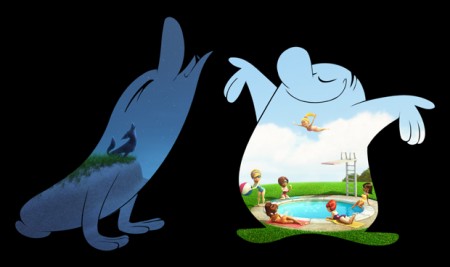
“Day & Night†utilizes character designs that seem to come out of the groovy seventies. This is a Hollywood version of Zagreb, which was a Yugoslavian variation of UPA, and the filmmakers try to attach a story that also feels redundant of some of those many seventies student films.
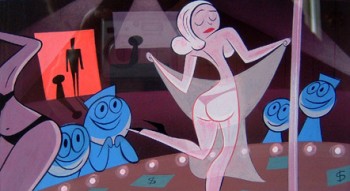 Teddy Newton, the director, seems to like the “moderne” style of animation. His past directoral effort, Boys Night Out (co-directed with Bert Klein), and his character designs all push toward what I call the CalArts style, an angular take on mid-Fifties animation styling. Basically, to me, this style has nothing to do with art and all to do with regurgitating the work of other artists who reworked art. It’s all too intermural – there’s nowhere for it to go.
Teddy Newton, the director, seems to like the “moderne” style of animation. His past directoral effort, Boys Night Out (co-directed with Bert Klein), and his character designs all push toward what I call the CalArts style, an angular take on mid-Fifties animation styling. Basically, to me, this style has nothing to do with art and all to do with regurgitating the work of other artists who reworked art. It’s all too intermural – there’s nowhere for it to go.
I can’t just stop with this Pixar short; many other shorts made recently have this same feeling as though they’re pushing some limit. In fact, what they’re all doing is limiting themselves with the past history of animation, and not always the best animation.
When the Lasseter/Disney troupe decided to rework Goofy in a Hollywood short a couple of years ago with Goofy How to Hook Up Your Home Theater, to me there was more honor in the workman-like effort as they purposefully borrowed from some mediocre shorts. It might have been a more complex effort had they tried doing a good Mickey short, but they pulled this film off.
Hundreds of short films are being made quickly via the new media. We can see them all over YouTube these days. Student films glut websites; one or two of them actually are well-realized. I just wish there were more concern for story. More attention has to be paid to this part of the film; it’s more imortant than the animation, the design or the music.
Day & Night makes me feel as though they started with the style and tried to work the story into it. It really doesn’t work on any intellectual level. I wonder how many young people actually go about making their films this way. Start with the look and the design, then wrap a story into it. Yet, the reason to see a film has nothing to do with the design; it’s all about the story. What do you have to tell me?
Actually, I’m not sure it ever was a better time for the short film. It always seems to come down to one or two films, every year. They dominate the market and Festivals everywhere; those are the one or two films that create the conversations after those Festivals. In fact, it’s the one or two smart artists that come up with these shorts, and there will always be these infrequent artist among the many.
Here are a handful of random shorts and filmmakers (off the top of my head) I’ve liked recently:
-
The House of Small Cubes by Yojiro Takita, was a beautifully constructed, animated and produced short that deserved its Oscar. It gave us several ADULT themes that were finely developed and executed.
Skhizein by Jérémy Clapin was a well crafted film with an idea that, at first, seemed to clever for its own sake, but turned out to be a short piece of genius that held up viewing after viewing. The use of cgi to creat a mix of flat and 3D surfaces just added to film’s depth.
Andreas Hykade‘s most recent short, Love and Theft, is a beautifully graphic free flowing paean to animation and linear art. Like all other Hykade shorts it turns to rich primary colors that seem to be all his own style. He seems to be entering the master class of animation film makers.
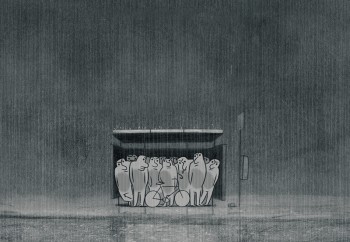 In Rains by David Coquard-Dassault, a sudden rainstorm initiates a lovely and poetic piece that simply gives us delicate images of those reacting to the weather. It’s so quiet, witty and original.
In Rains by David Coquard-Dassault, a sudden rainstorm initiates a lovely and poetic piece that simply gives us delicate images of those reacting to the weather. It’s so quiet, witty and original.
Aardman seems to have perfected the animated short film. Their last Wallace & Gromit film was so well-tuned, one almost took it for granted. Yet, in most of the shorts seen last year, this one stood out for extraordinarily high filmmaking standards. Even their more experimental shorts, such as the The Pearce Sisters Directed by Luis Cook does 2D animation using cgi and creates a dark mood with simple and effective means. All of their shorts are well written, well cut and intelligent; always crafted at the highest possible caliber. This includes every one of the films they’ve done for television. Pixar should study their films a little closer.
The Simon’s Cat series by Simon Tofield are beautifully done shorts featuring the same cast, beautiful linear design and well animated characters. The films are wordless, yet they all have a love of humanity and observation of the world around us that comes across as funny and touching, both at the same time. These shorts are made using Flash, yet don’t have that tedious cut-out feel of the tiresome pop from-pose-to-pose animation that the medium seems to engender.
Word is out that the next Pixar feature will also be preceded by a short. Cars 2 will have a Toy Story short accompanying it. How appropriate. Hopefully, they’ll get it right with the stable of characters the whole world loves. Perhaps it’ll give them the chance to show us what really happened to Bo Peep.
By the way, a good place to see shorts that are more challenging is at Ian Lumsden’s Animation Blog. It’s worth paying attention. The videos he features and analyzes often don’t show up elsewhere.
Commentary &Daily post 06 Jul 2010 08:33 am
Notes and bits
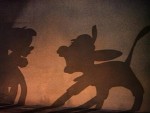 – Jaime Weinman has an excellent post on his blog. He posts the donkey-change scene from Pinocchio with the music only. It accents the terror in the sequence and shows off the brilliance of the Leigh Harline score.
– Jaime Weinman has an excellent post on his blog. He posts the donkey-change scene from Pinocchio with the music only. It accents the terror in the sequence and shows off the brilliance of the Leigh Harline score.
Something else worth watching during the sequence is the brilliant use of direction. The camera moves brilliantly from left to right, never crossing up or confusing where any of the characters are. The necessity of this is magnified when we pick up Jiminy running to and into the saloon. No one ever crosses the 180, yet the violence of the sequence is always growing. And this is all with only a music track. It’s great film making.
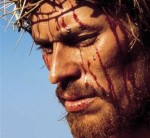 This reminds me that I recently watched a bit of Martin Scorcese‘s The Last Tempatation of Christ. There was a scene where Christ, Willem DeFoe sat at the edge of a hillside talking with a follower. The camera followed the 180 strictly. Then Christ makes a wild gesture with his hands, and the camera swirls with it. From then on the image has crossed the 180, and we’re looking at a wholly different setup.
This reminds me that I recently watched a bit of Martin Scorcese‘s The Last Tempatation of Christ. There was a scene where Christ, Willem DeFoe sat at the edge of a hillside talking with a follower. The camera followed the 180 strictly. Then Christ makes a wild gesture with his hands, and the camera swirls with it. From then on the image has crossed the 180, and we’re looking at a wholly different setup.
It was one small setup in a larger film reminding me that Scorcese, one of our elder statesmen now, still directing vibrantly, is more alive and challenging than ever. He uses all the extensive knowledge he has to break all the rules. Rent this movie or get another lesser known Scorcese film, and see what I’m talking about.
His work is an inspiration.
Amid Amidi has posted a wonderful piece on the passing of Betty Kimball. The photos and drawings of her by her late husband, Ward, are priceless. You’ve probably all seen it at Cartoon Brew, but if you haven’t, go there.
 - Brian Sibley has had a great blog since 2006. Called the blog. This has been a daily stop for me ever since I found it. Brian, who writes plays, scripts and books, uses this blog to discuss many cultural events and thoughts that pass by his life. This includes interesting and fine comments about many movies and plays that have opened. There’s a lot there in an entertaining and informative style.
- Brian Sibley has had a great blog since 2006. Called the blog. This has been a daily stop for me ever since I found it. Brian, who writes plays, scripts and books, uses this blog to discuss many cultural events and thoughts that pass by his life. This includes interesting and fine comments about many movies and plays that have opened. There’s a lot there in an entertaining and informative style.
Well, perhaps you may have missed that he’s just begun a new blog called decidedly disney. This one has as its focus, obvously, Disney and Brian has a lot to say about them. Take a look.
- Bill Benzon wrote a recent, thoughtful piece on the blog, On The Human. Here, he espouses the premise that “nothing in human psyche and society makes sense except in the light of cultural evolution.” He posits thoughts about Nina Paley’s feature, Sita Sings the Blues as support for this idea. If you find it too heady for you, at least scroll down to the midway point to read his comments of Sita.
Benzon is one of the finest intellectuals interested in animation and this article explains why.
- If you haven’t read the couple of posts Mark Mayerson has written about character and story structure particularly concerning Toy Story 3, I suggest you take a look.
“Do what we can, summer will have its flies: if we walk in
the woods, we must feed mosquitoes: if we go a-fishing,
we must expect a wet coat.†— Ralph Waldo Emerson
- Jeff Scher‘s latest Op Ed opus appears in today’s NYTimes. Summer Hours is the perfect thing for the torrid summer day (like we’re experiencing in NY today.) A cool drink of iced tea. The perfect music is, once again, by Shay Lynch.
Jeff Scher‘s website.
Shay Lynch‘s YouTube page.
Commentary &Festivals &Photos 04 Jul 2010 08:00 am
Things I Love
- I thought today that I’d post a bunch of photos of things I love in my studio. If you’ve ever seen my office, in the studio, you’ll see that it’s a warren of a mess of things. Lots of books, paper, awards, and other crap.
I’ve always been a puppet fan and as a result people have sent me and given me gifts of a lot of puppets. Most of them are gems that hang from shelves and cover books and tapes.
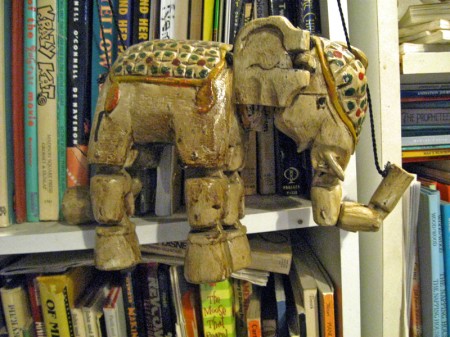
These first four are puppets that were gifted to me.
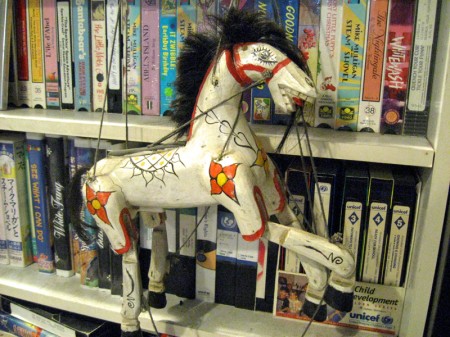
They’re all more for display than actually using for marionette shows.

I also love the Japanese edition videos of two of
my films on the shelf behind the witch.
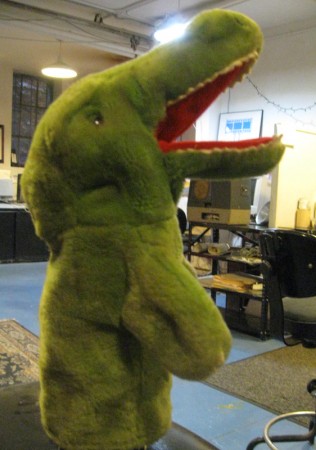
This crocodile hand-puppet was given to me by John Dilworth
during the production of LYLE LYLE CROCODILE in 1987.
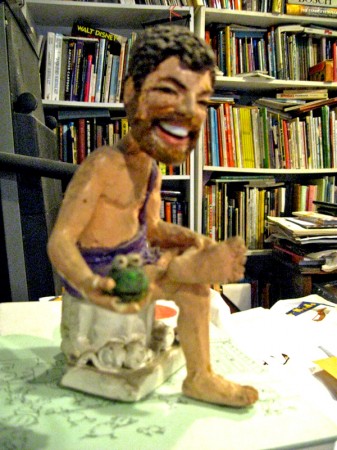
Here’s a sculpture of me made by a Russian animator on staff,
Mark Bykov, back in the ’80s. I don’t know why he made me a
caveman, but I’m holding the Dancing Frog character.
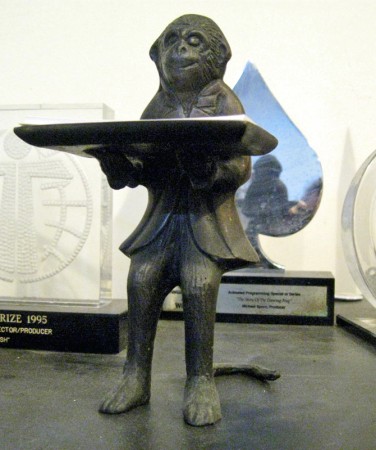
This bronze monkey is a birthday gift given me by my Heidi.
It’s a business card-holder, and it holds a bunch of my cards.
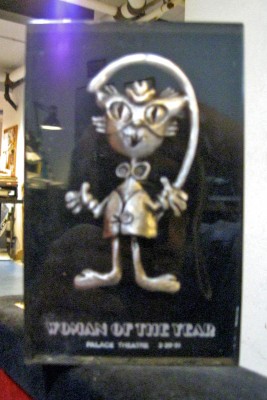
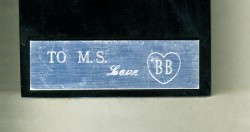
This paperweight was designed by Tony Walton for Lauren Bacall.
She gave it to me as a parting gift on the play “Woman of the Year”.
The engraving: to MS (Michael Sporn) love BB (Betty Bacall).
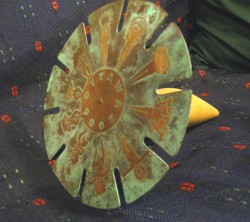
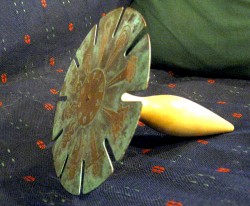
This bronze Praxinascope was the award given me in Ottawa
for THE MAN WHO WALKED BETWEEN THE TOWERS as the
Best Children’s film that year.
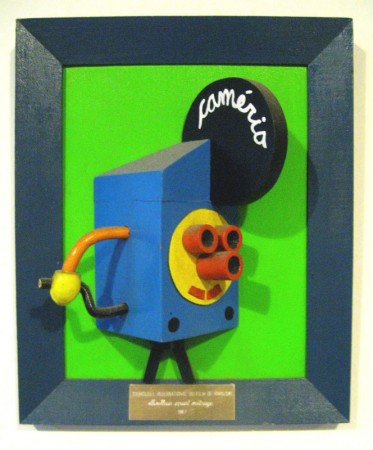
Finally, this award was given to me for THE MYSTERIOUS
TADPOLE from the Caroussel International du Film de Rimouski
a Canadian festival for children’s films. It’s an original object.
Commentary 25 Jun 2010 06:19 am
Thoughts on TS3D
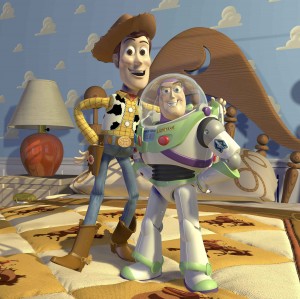 - Toy Story 3 is such a difficult film for me to write about that I am very inclined not to say much of anything more than the negative sentence I contributed last week in passing while commenting on Mike Barrier’s writing. However, negative I’ll be I feel it’s probably important, at least for my own ego, to write down my thoughts. I know most of you won’t agree with me, but that’s not really important to me. I just wanted to air my considered comments.
- Toy Story 3 is such a difficult film for me to write about that I am very inclined not to say much of anything more than the negative sentence I contributed last week in passing while commenting on Mike Barrier’s writing. However, negative I’ll be I feel it’s probably important, at least for my own ego, to write down my thoughts. I know most of you won’t agree with me, but that’s not really important to me. I just wanted to air my considered comments.
As such, I’ve decided to break those comments into two:
1.Things I liked about Toy Story 3.
- There’s a funny bit toward the front of the film, wherein Woody, the only toy not to be tied in a plastic bag waiting for the soon-approaching garbage truck, runs up and down several lawns in a frenzy trying to save his friends. The animation on the run is hilarious. Whoever animated it captured the lunacy of a marionette without strings running with arms and legs fluttering about in an absolute chaos.
The 3D is excellently crafted. Unlike the Dreamworks approach to 3D there are no characters or objects being thrown at the audience in a cheap attempt to create a gasp or shock moment. This is no MONSTERS VS ALIENS where the audience has to keep ducking throughout. Toy Story sets up a comfortable 3D enviironment and casually invites you in. I enjoyed it and applaud the design of that element of the film.
The voice work, as in most Pixar films, is excellent. Casting is fine, particularly Michael Keaton as the Ken doll. Tom Hanks certainly carries his character even when the animation doesn’t completely. Ned Beatty creates a very odd villain in a quietly voiced character with lots of venom but no loud shouting. It is rather sinister in the end.
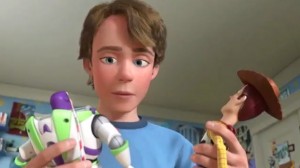 2. Things I didn’t like about Toy Story 3.
2. Things I didn’t like about Toy Story 3.
- Pixar films have gotten into something of a formula, and that formula keeps heading closer to violent, action-adventure movies as opposed to the sensitive stories they brought us early on. This story is a Rube Goldberg contraption of a film. Patchwork and obvious in its construction, the film races from one locale to another back and forth trying to keep viewers on the edge of their seat throughout. The characters, for the most part, are always in danger, and the effort is to try to keep up with the twists and turns, especially of Woody, to follow things. As I said, this has become the pattern of recent Pixar films They spend considerable time setting up their characters and then throw them and us on a roller coaster ride trying to climax to an ending. In Wall-E, there’s was a wonderfully silent opening half hour of a movie before we were shuttled to outer space where characters raced from one end of the space ship to the other, inside and out, as the audience was dragged along. Up featured a wild chase around an island which brought the characters back, in a frenzy, to fight off financial villains in their own world. The action/adventure element The Incredibles was probably the most crucial to that film since it was a film about superheroes, and we knew going in that we’d be seeing violent chase-type action.
However, Toy Story 3 is all chase from the opening to the close. Consequently, I never once cozied up to the characters as I had in the first film, and even the second. This film, to me, just features the characters and voices without giving us much character.
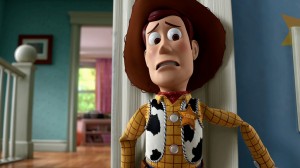 Then, continuing with the story, we’re given a climax that is so violent that parents of young children will be bothered by the horrific moments of tension that their children will have to endure getting to the end. Threatening to incinerate all of the characters comes as something of a reality that is milked for all its soppiness. (Characters waiting to be trashed form a ring holding hands so we know how much they mean to each other, but more to make us endure a longer, slower death. I found it unconscionable of the film makers, who are – let’s face it – making a children’s film for all ages. This is one film I would have given a PG-13.
Then, continuing with the story, we’re given a climax that is so violent that parents of young children will be bothered by the horrific moments of tension that their children will have to endure getting to the end. Threatening to incinerate all of the characters comes as something of a reality that is milked for all its soppiness. (Characters waiting to be trashed form a ring holding hands so we know how much they mean to each other, but more to make us endure a longer, slower death. I found it unconscionable of the film makers, who are – let’s face it – making a children’s film for all ages. This is one film I would have given a PG-13.
I didn’t quite feel the animation was on par with Pixar’s best. The mix of quiet, sensitive movement with the popping from pose to pose style just doesn’t work for me, and I wish they would have chosen one style over another. Don’t get me wrong, technically the film is stunning, as you would expect it to be from this company, but the artistic choices weren’t always what I would have chosen.
Randy Newman’s score rambles about a bit too much for me. His score for Toy Story 1 stood out as something different for an animated feature. In Toy Story 2, he introduced his Oscar-winning song and let that tune carry the picture in a very melodic way. The score to Toy Story 3 is all in short spurts of action music, which is obviously locked into the violently short scenes featured throughout the movie. I wish he had found a way to make this feel less like an action-adventure movie.
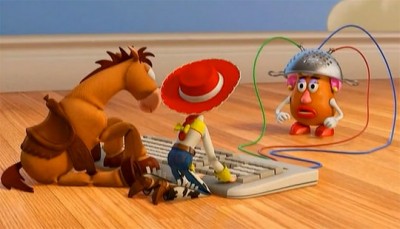
Actually, I have plenty more to say, but I think I should stop here. I didn’t have a great time at the movies watching this film. I wanted more from this magnificent studio. After their initial films, I was convinced that we’d be watching an animation company mature into something brilliant. If all they’re going to offer is an animated variant of the typical fare we’re offered from Jerry Bruckheimer, I’m not sure I see the point.
Articles on Animation &Books &Commentary 19 Jun 2010 09:05 am
Happy belated Birthday, Mike
 - This past Tuesday, Amid Amidi celebrated the birthday of Mike Barrier with a very respectful commentary on Cartoon Brew. This was followed quickly by more kind words and an acutely written article on Mark Mayerson’s excellent blog. Both were met with positive comments from the people following the two sites.
- This past Tuesday, Amid Amidi celebrated the birthday of Mike Barrier with a very respectful commentary on Cartoon Brew. This was followed quickly by more kind words and an acutely written article on Mark Mayerson’s excellent blog. Both were met with positive comments from the people following the two sites.
I was pleased to see both posts and thought of leaving my own comment on each of them. However, I have my own blog and have probably too much to say.
Mike and Phyllis Barrier are very dear friends to me. When they lived in Washington D.C. I took many weekend trips to see some art exhibit or special film event or just a visit to meet with them. We grew close, and even though now we’re half a continent away, I still feel there’s something dear and special about our friendship.
However, long before we became friends, I was a fan of Mike’s writing, criticism and commentaries about the world of animation. Those early issues of Funnyworld Magazine became seminal to my knowledge about the history of the medium. I also knew inherently that this was a widespread thing. Anyone who was anyone, student or professional, knew the magazine. I remember going to my first animation festival – Ottawa ’76. I witnessed no fewer than three conversations about Chuck Jones vs Bob Clampett, all precipitated by a couple of pieces in Funnyworld. No matter how ludicrous it all seems now, Mike had inadvertently reignited something of a feud in Hollywood between the two directors even though he wrote that Jones and Clampett were both brilliant.
The magazine made a large foothold among all animation-lovers. Eventually, it, like most small and independently published magazines, suffered financially until it had to be stopped. Back issues are still being sold for enormous amounts of money.
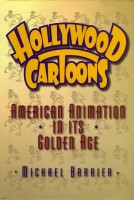 Mike kept pushing ahead for years and years and years on his book, a history of Hollywood animation and it was always a treat for me to discuss it with him. Like many other people, I panted for the day when the book would finally make it to the stores. Once Hollywood Cartoons: American Animation in Its Golden Age was published, I immediately plowed through it, then started over and read it again. I’ve re-read the book every year since. It’s the pinnacle of animation history, in my opinion. There’s nothing as exacting or precise or historically accurate on the market.
Mike kept pushing ahead for years and years and years on his book, a history of Hollywood animation and it was always a treat for me to discuss it with him. Like many other people, I panted for the day when the book would finally make it to the stores. Once Hollywood Cartoons: American Animation in Its Golden Age was published, I immediately plowed through it, then started over and read it again. I’ve re-read the book every year since. It’s the pinnacle of animation history, in my opinion. There’s nothing as exacting or precise or historically accurate on the market.
I also remember a point when Mike was hired to write a history of Warner Brothers cartoons. During one visit to his home in Alexandria, he surprised me by handing me the manuscript and asking me to read it. That was one of the fastest reads I’ve gone through. Excellent, of course; I was properly overwhelmed. On another day, he opened a draw of large-sized chromes of WB artwork. BG’s and animation drawings photographed beautifully and sitting there for me to drool over. It was a treasure-filled weekend for me. The book was cancelled by Warners when they suddenly had a power shift, and a piece of brilliant historical writing was lost. I’ve always hoped Mike would somehow rework that manuscript so that the ultimate history of WB would be made public.
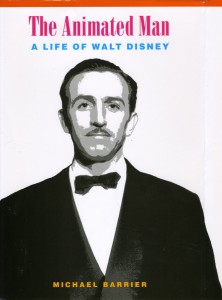 The Animated Man: A Life of Walt Disney, is equally brilliant, even though it seemed to disappoint some animation people. The book follows the story of Walt Disney, the man – just as the title states. It took its subject seriously, and when Walt lost interest in animation, so did the book. We learned more about Fess Parker, Treasure Island and the theme parks than we ever expected from a book about Disney. And, realistically, that’s the way it should have been. Mike painted a portrait of a unique man, and it made him human. Something that hadn’t been attempted before – except by some detractors who tried to make their names by slandering Walt and finding the most negative stories they could concoct.
The Animated Man: A Life of Walt Disney, is equally brilliant, even though it seemed to disappoint some animation people. The book follows the story of Walt Disney, the man – just as the title states. It took its subject seriously, and when Walt lost interest in animation, so did the book. We learned more about Fess Parker, Treasure Island and the theme parks than we ever expected from a book about Disney. And, realistically, that’s the way it should have been. Mike painted a portrait of a unique man, and it made him human. Something that hadn’t been attempted before – except by some detractors who tried to make their names by slandering Walt and finding the most negative stories they could concoct.
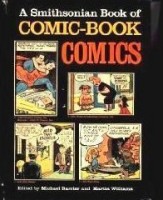 Aside from these two books, Mike wrote Carl Barks and the Art of the Comic Book, a history of Barks and the amazing comic books he wrote and illustrated for Disney. Mike has also coauthored, with Martin Williams, The Smithsonian Book of Comic Book Comics, a complete history of the comic page characters that developed into long-running comic books. It’s a big book with lots of well-produced color comic pages. The comic pages are printed on the same newsprint that the originals were printed on.
Aside from these two books, Mike wrote Carl Barks and the Art of the Comic Book, a history of Barks and the amazing comic books he wrote and illustrated for Disney. Mike has also coauthored, with Martin Williams, The Smithsonian Book of Comic Book Comics, a complete history of the comic page characters that developed into long-running comic books. It’s a big book with lots of well-produced color comic pages. The comic pages are printed on the same newsprint that the originals were printed on.
Oh, yes, he also has a great website.
Now, Mike has turned 70 and seems to be in high form. I know he’s working on a couple of other books and I anxiously await getting them in my hands. Mike’s a friend, a good friend. Aside from that he’s a great and knowledgeable writer of animation. Even when I don’t agree with what he has to say, his writing makes me think about my medium and pushes me to think deeper. (A good example of this is his review of Get To Know Your Dragon which pointed out that we’ve lost something since the glorious Fanny trilogmade in the early thirties. It got me to think seriously about how to bring back that slower paced aura from the past, the one that allowed characters to develop – really develop. Not in the clichéd way of today’s animation but in the full and deep way of the films of the golden era.)
Many like to put down Mike’s writing for being too negative. I know it isn’t. I know that most other writing is too accepting, too forgiving. Has there been a serious review of Toy Story 3? I only see glowing reviews for an amazingly clever film that whisks us through a hurly-burly of confusion until the sappy moments at the end. No characters properly developed, or enlarged. Just whirlwind story – very cleverly done. We need better film critics, not just animation critics. Ironman II isn’t ok, nor is The A Team, nor is Shrek 4. They’re franchises not movies. MacDonald’s III. Yes, aspects of them all are fun, but that’s not enough. We need good movies that are better than clever, and we need more reviewers like Mike Barrier. Those whose historical accuracy is above and beyond most others and whose taste is shaped by a history of watching many many films as well as by a strong understanding of the medium. He knows what he’s writing about, is not afraid to say it, and I’ll follow him anywhere.
Happy Birthday, Mike Barrier, may you have many more.
Articles on Animation &Comic Art &Commentary 10 Jun 2010 08:19 am
Canemaker & Gross & Kimball and Mars
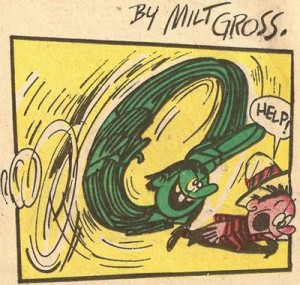 - John Canemaker has a new article about Milt Gross for his monthly piece at Print Magazine‘s website. Essentially, it’s a loving piece reviewing the new collection of The Complete Milt Gross which was edited by Craig Yoe.
- John Canemaker has a new article about Milt Gross for his monthly piece at Print Magazine‘s website. Essentially, it’s a loving piece reviewing the new collection of The Complete Milt Gross which was edited by Craig Yoe.
I’ve long loved Milt Gross’ work and have closely studied the MGM shorts he did. They don’t quite capture the zaniness of the comic strip work, but he was obviously an inspiration for so much of the animation that was done in Hollywood back then.
Wouldn’t it be interesting if some people found inspiration in his work today and applied it to their animation artwork. Something other than the endlessly angular characters that we’re force-fed these days!
- Speaking of John Canemaker, he’s just loaned me a Ward Kimball scene from Peter and the Wolf. It’s about 500 drawings long, and will take me forever, but I’m going to start posting it next week. The walk cycle of all walk cycles. Something to look forward to (endless scanning and downloading), a great piece of animation to study.
The image above is a good sample.
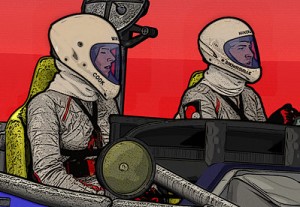 Mars: SXSW will be playing tonight at the Brooklyn Academy of Music Cinemafest in NYC at 9:30 PM. There will be one show only. Filmmaker, Geoff Marslett will be there along with several cast and crew!
Mars: SXSW will be playing tonight at the Brooklyn Academy of Music Cinemafest in NYC at 9:30 PM. There will be one show only. Filmmaker, Geoff Marslett will be there along with several cast and crew!
The film is a completely rotoscoped space adventure done by the guy who gave us Monkey vs. Robot and Bubblecraft.
For a trailer go here.
Art Art &Commentary 30 May 2010 09:19 am
The Best Years
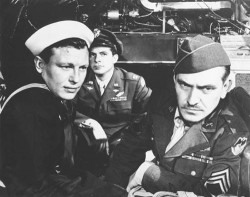 - The magnificence of William Wyler‘s film, The Best Years of Our Lives, cannot be overstated. To me, it’s a near-perfect movie. The direction, the script, the cast, the cinematography and the music all done by masters at their peaks blends into an extraordinary film.
- The magnificence of William Wyler‘s film, The Best Years of Our Lives, cannot be overstated. To me, it’s a near-perfect movie. The direction, the script, the cast, the cinematography and the music all done by masters at their peaks blends into an extraordinary film.
When I was 11, this film was about to start on The Late Show, a local CBS late night movie that began at 11:15pm. My father asked me if I wanted to stay up to watch it. He said it was one of the all-time greats. Now, I have to admit I didn’t always agree with what he felt were the all-time greats, but I stayed. Within ten minutes, I was in tears as the three military men return to Boone City, their small home town. The cab drives by the many small stores and houses in the area, and little more than the sight of these passing buildings wells the tears in your eyes as you feel what these three guys are feeling. That Wyler would have accomplished so much emotion in so short a time is extraordinary.
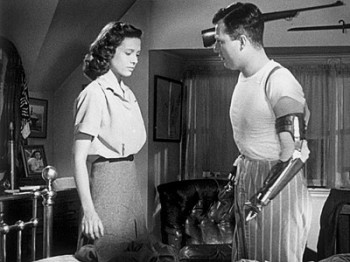 I stayed with the 2½ hr. film, even though my father fell asleep hours before the end. He was right, it was an all-time great. I’ve since seen the film at least 50 more times. In the past two months, I’ve spent a lot of time at home, recovering from an operation, and have seen many, many movies over that time. Last night, TCM aired it again (the second time in the last two weeks) for Memorial Day. I was pulled into it again, and I’m happy for it.
I stayed with the 2½ hr. film, even though my father fell asleep hours before the end. He was right, it was an all-time great. I’ve since seen the film at least 50 more times. In the past two months, I’ve spent a lot of time at home, recovering from an operation, and have seen many, many movies over that time. Last night, TCM aired it again (the second time in the last two weeks) for Memorial Day. I was pulled into it again, and I’m happy for it.
Wyler, it seems, had absolute patience for long self-explaining scenes. He gave characters plenty of time to pause and think, and their thoughts register fully and loudly to us. It’s amazing business that today’s films (and probably their audience) cannot sit still to watch. With this film, you can see how much you’re missing in that impatience.
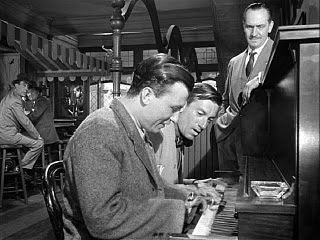 The photography by the great Gregg Toland has to be second only to his work on Citizen Kane. The deep focus imagery is used to pull strong emotion and tell the story more simply. As Homer (Harold Russell) and Butch (Hoagy Carmichael) play chopsticks in the foreground, we’re watching Fred (Dana Andrews) make a desperate and sad phone call far in the distance of the bar. While Homer and Wilma marry to the right of the screen, Fred, in the foreground, is watching Peggy (Teresa Wright) in the distance. There are those scenes of Fred walking among the detritus of the Air Force as hundreds and hundreds and hundreds of fighter planes line up for destruction.
The photography by the great Gregg Toland has to be second only to his work on Citizen Kane. The deep focus imagery is used to pull strong emotion and tell the story more simply. As Homer (Harold Russell) and Butch (Hoagy Carmichael) play chopsticks in the foreground, we’re watching Fred (Dana Andrews) make a desperate and sad phone call far in the distance of the bar. While Homer and Wilma marry to the right of the screen, Fred, in the foreground, is watching Peggy (Teresa Wright) in the distance. There are those scenes of Fred walking among the detritus of the Air Force as hundreds and hundreds and hundreds of fighter planes line up for destruction.
Hugo Friedhofer was a great arranger and song writer. His score for this film stands out as one of the great scores of all time. It carries you through the movie and strengthens the work of every other brilliant craftsman who worked on it. The music is brilliant.
I can’t say enough about this film. It’s Memorial Day, and writing about it gives me a chance to mention the holiday. But I’m certainly honoring what I feel is one of the great films of my life. I hope all of you have, at least, seen it once. If not I urge that you do. I doubt you’ll ever see the likes of it made today.

Photo by Steve Fisher
Remember the troops for Memorial Day.
Commentary 27 May 2010 07:50 am
Joanna Quinn / Brad Bird
- I received the following press release from Joanna Quinn yesterday. Normally, I would not reprint a press release, but I think so highly of Joanna’s work and recognize that this is a truly special honor and occasion for anyone in the animation community, that I feel compelled to post it as is:
JOANNA QUINN – AWARD and EXHIBITION
Joanna Quinn one of the UK’s most celebrated filmmakers whose animated films have received many international Awards including 2 Oscar nominations, BAFTAS and Emmys, is to receive yet another major award at the 25th Cinema Jove International Film Festival in Valencia, Spain.
In June 2010 she is being honoured with the prestigious award – ‘La Luna de Valencia’ (the Moon of the City of Valencia). Previous recipients of the award have included the internationally acclaimed film directors Guillermo del Toro (Pan’s Labyrinth), Stephen Frears (The Queen, My Beautiful Launderette), Richard Lester (Superman 2 & 3, Help!), veteran cult horror master Roger Corman and
animation heroes like Alexandre Petrov, Caroline Leaf, and Piotr Dumala.
The city is simultaneously hosting a major retrospective exhibition of Joanna’s films, drawings and Artwork entitled ‘Joanna Quinn: Arte Vs. Animación’, which was originally curated and exhibited at the National Media Museum in Bradford in October 2009 under the title ‘Drawings that Move – the Art of Joanna Quinn’.
Joanna commented:
“It’s a great privilege to be receiving this award – I’m overwhelmed at the thought of being honoured in the same way as all those brilliant film directors…wow. For me it’s wonderful to see a selection of 25 years of my drawings presented in one venue. Normally people never see the individual drawings and all the work that goes into my films, so it’s great that they’ll be able to see the whole process at
the exhibitionâ€.
Exhibition information:
Joanna Quinn: Arte Vs.Animación: 13.5.2010 – 12.7.2010
Vicerectorado de Cultura, Valencia tel: (34) 607 289 990 email: sgarciar@dib.upv.es
Festival information
25th Cinema Jove International Film Festival: 19.6.2010 – 26.6.2010
Cinema Jove, Valencia tel: (34) 963 301 625 email: prensa@cinemajove.com
For further details contact: Les Mills or Catrin Unwin
44 (0)2920 666418 or 44 (0)2920 226225
email: les.beryl@fut.net or studio.beryl@btconnect.com
- Michael Barrier has returned from Russia with some entertaining pictures and travel information. He’s also been the first to comment on Thad Komorowski‘s note about Brad Bird‘s escape from animation to start directing Mission Impossible 4.
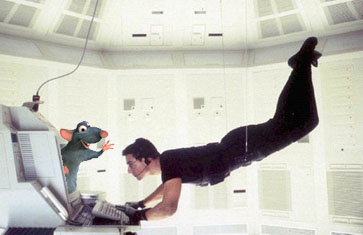 In writing his piece, Mike gets it right, I think, about changes in Pixar (post sellout to Disney) and Disney animation. It hasn’t been all good, and it looks like Bird is looking to improve his profile and financial fortunes by leaving animation behind. The same is probably true of Andrew Stanton who is now scheduled to direct a live action John Carter of Mars for Pixar. (Remember the animated tests Clampett did of this story back in the ’30s? It looked like the Fleischer Superman, years earlier.) Although in directing live action for Pixar, Stanton puts his toes in the water rather than jumping.
In writing his piece, Mike gets it right, I think, about changes in Pixar (post sellout to Disney) and Disney animation. It hasn’t been all good, and it looks like Bird is looking to improve his profile and financial fortunes by leaving animation behind. The same is probably true of Andrew Stanton who is now scheduled to direct a live action John Carter of Mars for Pixar. (Remember the animated tests Clampett did of this story back in the ’30s? It looked like the Fleischer Superman, years earlier.) Although in directing live action for Pixar, Stanton puts his toes in the water rather than jumping.
It’s questionable whether Bird will come back to animation. His fortunes, fame and pleasure will probably be greater in live action. Of course, the film will be crap (could anything called Mission Impossible 4 be anything but?) Remember that Tom Cruise plucked up J. J. Abrams from the first season of Lost to give him Mission Impossible III, thus making him an industry powerhouse in Hollywood. It’s not unlikely that the same could happen to Brad Bird.
Animation &Animation Artifacts &Commentary &Independent Animation &Puppet Animation 22 May 2010 09:05 am
Bits
- I recently received this comment from Amy Bunin, the daughter of Lou Bunin, and was afraid it might have been missed. So I’m posting it here.
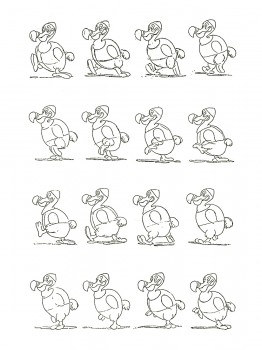 Just a note to say that my sisters and I have put our family collection of Lou Bunin’s puppets and artwork from Alice in Wonderland up for auction at Profiles in History.
Just a note to say that my sisters and I have put our family collection of Lou Bunin’s puppets and artwork from Alice in Wonderland up for auction at Profiles in History.
Lou’s stuff is on “Day 2″ of the auction. The sketches by Art Babbitt of the Dodo walking that are featured in Shamus Culhane’s Animation book (see above) –along with 10 or so other characters– are included: Lot 634. Wish us luck!
I have also started a blog on my father’s life and work – www.loubunin.com
Amy Bunin
This is an excellent blog with lots of information and stories about Lou Bunin and his work. I encourage you to go take a look.
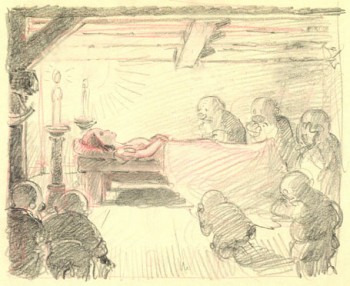 - John Canemaker ‘s most recent blog entry for Print Magazine is now posted and can be found here.
- John Canemaker ‘s most recent blog entry for Print Magazine is now posted and can be found here.
John writes a clear and full comparative study between the work of Albert Hurter, one of the principal designers of Snow White, and some of Giotto’s Renaissance painting.
He shows how Hurter may have been influenced. It’s a good read for any enthusiasts of Snow White, Hurter or Giotto.
Frank and Caroline Mouris have been making innovative, Independent animation forever. Their initial film, Frank’s Film, swept the world quickly and won the Oscar making a Frank a household name among animators in the 1970′s.
ASIFA-East is presenting an evening of their films on Tuesday, June 15. It’s sure to be an entertaining and enlightening event. Keep the date open to join the couple as they present their films.
